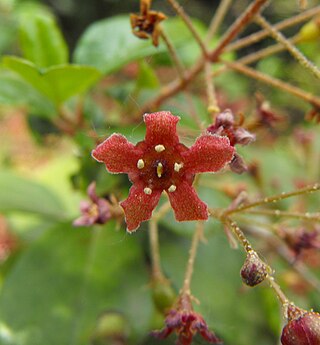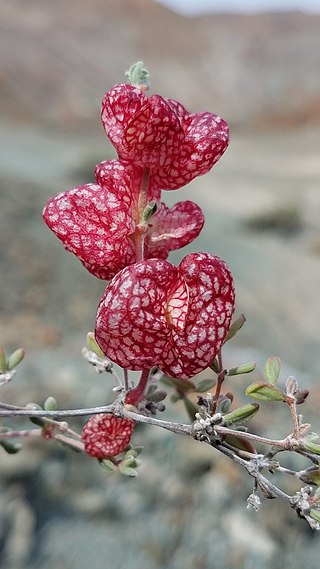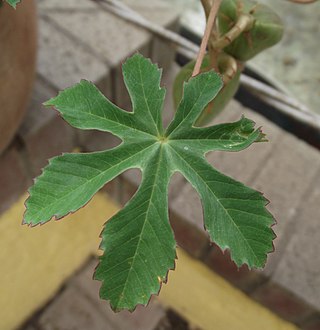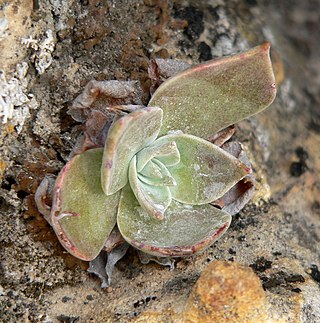
Agave shawii is a species of monocarpic succulent plant in the genus Agave, commonly known as Shaw's agave. It is a rosette-forming plant characterized by glossy, green leaves with toothed margins. After several years of slow growth, the plant puts all of its resources to produce a towering stalk of flowers, and then dies. The death of the flowering rosette is compensated by the growth of numerous clonal pups. This species is segregated into two subspecies, one native to the coast of southwestern California and northwestern Baja California, known commonly as the coast agave, and another native to the Baja California desert, known as the Goldman agave.

Ribes viburnifolium, is an uncommon North American species in the gooseberry family. It is known by the common names Catalina currant, Santa Catalina Island currant, island gooseberry and evergreen currant.

Harfordia macroptera is a woody perennial in the family Polygonaceae commonly known as rabbit's purse. It is the sole species in the genus Harfordia, which is endemic to the Baja California Peninsula. This plant is characterized by a unique, conspicuous bladder embellished with red to purple veins that surround the fruit. The sac-like structure is actually a dramatically modified bract, and assists in dispersal of the seeds through the wind.

Bursera microphylla, known by the common name elephant tree in English or 'torote' in Spanish, is a tree in the genus Bursera. It grows into a distinctive sculptural form, with a thickened, water-storing or caudiciform trunk. It is found in the southwestern United States and northwestern Mexico.

Euphorbia misera is a semi-succulent shrub in the genus Euphorbia commonly known as the cliff spurge or coast spurge. A drought-deciduous shrub, it is typically found as a gnarled, straggly plant occupying seashore bluffs, hills and deserts. Like other members of its genus, it has a milky sap, which can be found exuding out of the light gray bark when damaged. The alternately-arranged leaves are round and folded in the middle, with small hairs on them. The "flowers" can be found blooming year-round, and are colored maroon or yellow in the center with 5 white to light-yellow petal-like appendages attached outside. This species is native to the Baja California peninsula and Sonora in Mexico, and the coast of Southern California in the United States, where it is a rare species. It is threatened in some localities by the development of its coastal habitat, which tends to be prime locations for high-end residential and commercial developments.

Pachycormus is a monotypic genus of flowering plants in the cashew family commonly known as the Baja elephant tree, torote blanco, or copalquín. The single species Pachycormus discolor is endemic to the Baja California peninsula, with three varieties. This sarcocaulescent tree or shrub is characterized by its unique gnarled growth habit, skin-like exfoliating bark, and succulent nature, whose appearance has been colorfully described as "the proboscis of an elephant holding a nosegay," a "huge radish protruding from the ground," or "grotesque resemblances of the flexed limbs of a corpulent human being." This drought-deciduous species spends most of the year dormant, but following rains pinnate green leaves emerge, and in the late spring to summer the leaves yellow, fall, and give way to bright red, cream, or pink flowers that give it a striking appearance in bloom.

Antigonon leptopus is a species of perennial vine in the buckwheat family commonly known as coral vine or queen's wreath. This clambering vine is characterized by showy, usually pink flowers that can bloom throughout the year and large, heart-shaped leaves. A. leptopus is native to the Pacific and Atlantic coastal plains of Mexico, but also occurs as a roadside weed from Mexico south to Central America. It is widely introduced and invasive throughout tropical regions of the world, including in the south and eastern United States, the West Indies, South America, and the Old World tropics of Asia and Africa. This species is utilized for its edible tubers and seeds, but also for its horticultural properties as an ornamental vine in warmer parts of the world.

Cissus trifoliata, known variously as possum-grape, sorrelvine, vine-sorrel, or hierba del buey is a New World plant species in the grape family. It is native to the southern United States, Mexico, Venezuela, Colombia and perhaps Ecuador (Loja). It is also dispersed among some islands in the Caribbean.

Amoreuxia gonzalezii is a rare species of flowering plant in the Bixaceae known by the common names Santa Rita mountain yellowshow, Santa Rita throwup weed, saiya and temaqui. It is native to Sonora in Mexico, its distribution extending just above the border into Arizona in the United States, where it occurs in the Santa Rita Mountains of Pima and Santa Cruz Counties. It has also been found in the States of Sinaloa and Jalisco to the south. It is also present in the Sierra de la Laguna of Baja California Sur.

Ambrosia monogyra is a species of flowering plant in the sunflower family commonly known as the singlewhorl burrobrush, leafy burrobush, slender burrobush, and desert fragrance. Ambrosia monogyra is native to North America and is typically found in canyons, desert washes, and ravines throughout arid parts of the southwestern United States and northern Mexico. This species has green, threadlike leaves that emit a distinctive odor when crushed, and flowers from August to November. The fruits have distinctive wings in their middle that aid in dispersion through wind and water.

Solena amplexicaulis, commonly known as the creeping cucumber, is a species of plant in the family Cucurbitaceae, native to tropical southern Asia. The fruits, leaves, roots and shoots have use as food and in traditional medicine.

Dudleya gatesii, known by the common name as Gates'liveforever, is a species of perennial succulent plant in the family Crassulaceae. It is native to the central desert of the Baja California peninsula, found growing along dry and rocky outcroppings. It is characterized by red inflorescences topped with white flowers, bracts that are often reflexed downwards, and a rosette of dark-green leaves turning reddish.

Dudleya rubens is a species of succulent perennial plant in the family Crassulaceae known by the common name as the San Francisco liveforever, native to the mountains of Baja California Sur. It is a rosette-forming plant with waxy leaves, characterized by branching stems and dull red to apricot flowers. It is only found above 500 metres (1,600 ft) in the Sierra de San Francisco and the Sierra de la Giganta ranges in Baja California Sur, primarily on north-facing volcanic slopes.

Dudleya arizonica is a species of perennial succulent plant commonly known as the Arizona chalk dudleya and the Arizona liveforever. A member of the genus Dudleya, this species is characterized by long, red flowers that adorn a waxy rosette of succulent leaves. It resembles a reduced desert form of the more coastal chalk dudleya, Dudleya pulverulenta, but differs in its smaller stature, lower number of leaves, and orientation of the flowers. Native to the southwestern United States and northwestern Mexico, it is widespread in range, but is primarily found in scattered, widely separated localities. It can be found as far west as coastal Ensenada to the desolate desert ranges of Nevada. It is one of two species of Dudleya that occur in Arizona, the other being Dudleya saxosa subsp. collomiae, and is the only species on mainland Mexico and in Utah.

Dudleya acuminata is a species of succulent perennial plant in the family Crassulaceae known by common name as the Vizcaino liveforever. A rosette-forming leaf succulent, it has reddish yellow flowers that emerge from April to May. It is native to the Pacific coast of the Vizcaino Desert on the Baja California Peninsula, and on neighboring islands.

Fouquieria diguetii, known by the common names Adam's tree,palo Adán, and Baja [California] Tree Ocotillo, is a plant in the family Fouquieriaceae native to the southern half of the Baja California Peninsula, and the coasts of Sonora and Sinaloa. It is a semi-succulent and deciduous plant related to the ocotillo and the Boojum tree. It is distinguished by its bright red, tubular flowers, a shrub to small tree habit, and conical, paniculate inflorescences.
Sedum alamosanum, known by the common name Alamos stonecrop, is a rare succulent plant native to the mountains of northwestern Mexico. It is characterized by white flowers and bluish-green leaves. It is found in Baja California Sur, Chihuahua, Durango, Sinaloa and Sonora.

Ebenopsis confinis is a species of drought deciduous perennial shrubs in the Legume family known commonly as dog poop bush. The English vernacular name is a result of the distinctive woody fruits which resemble dog poop. The plant is referred to locally as palo fierro. In addition to the fruits, this species is characterized by its small, equally-paired pinnate leaves and a condensed capitulum. This species is distributed from southern Baja California to the cape of Baja California Sur, and on the coast of Sonora.

Nolina beldingii is a species of perennial flowering plant in the family Asparagaceae known commonly as the Cape nolina or Belding's beargrass. It is an arborescent monocot growing up to 7 metres (23 ft) high, with fissured bark on a trunk topped with leaf rosettes. The narrow leaves are up to 1.15 m (3.8 ft) long, and are used as thatching by local peoples. This species is endemic to Baja California Sur in Mexico, where it grows only in the highest reaches of the Sierra de la Laguna. It is found primarily in oak forests at elevations over 1,000 m (3,300 ft) along rocky granite outcrops.

Ruellia californica is a species of flowering plant in the Acanthus family commonly known as the rama parda or flor del campo. This evergreen shrub is native to the Baja California peninsula and neighboring coastal Sonora. It is characterized by showy, funnelform blue-purple flowers that bloom throughout the year. There are two subspecies, one endemic to Baja California Sur, and they primarily differ in their presence or absence of hairs on their foliage. This plant is cultivated as an ornamental, and is used to provide a colorful accent to desert and dry gardens.





















